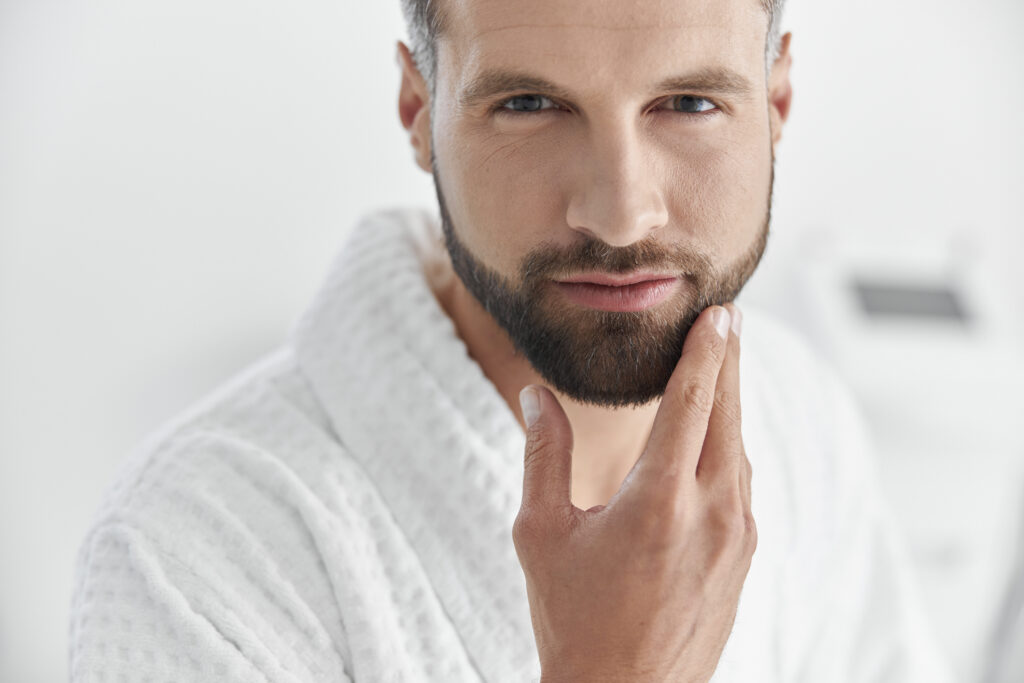Half of the people in the world have dandruff, according to estimates. That statistic has been repeated and reported by doctors, researchers and hygiene companies since at least 2005.
Although that estimation is two decades old, the global market for dandruff treatment was valued at more than $10 billion last year. That statistic from Data Bridge Market Research lends credence to the prevalence of the itchy, flaky skin condition.
Likely, because of the hormone androgen, men are more prone to dandruff, the mildest form of the skin condition seborrheic dermatitis, than women are, according to a review of data made available by the National Library of Medicine. And it’s not limited to just their heads.
Beardruff, or beard dandruff, can be as itchy and irritating as the scalp condition and possibly as off-putting as a bat in the cave or spinach in the teeth. At least that’s what the beauty industry might have conditioned society to believe, three researchers have asserted.
One team titled their article on dandruff’s causes and treatments “Dandruff: The Most Commercially Exploited Skin Disease.” And a second stated, “Dandruff causes more social and psychological problems than medical ones. The personal care industry conveniently offers its range of products targeting the psychological aspects of dandruff through carefully planned advertisements and through various products for dandruff.” And the duo, which included one author from the commercial exploitation paper, asked, “Should we accept dandruff as part of our normal physiology?”
While it might be true that dandruff does not present a medical problem unless seborrheic dermatitis becomes severe enough to crack the skin, many men likely don’t want fragments of dead skin dotting their beards.
Dermatologists have offered three do’s to handle removing beardruff.
1. Before cleansing your beard and face, use a beard brush to exfoliate the skin beneath your beard gently, the American Academy of Dermatology recommends. That lifts the accumulation of facial flakes and allows medicated treatments to permeate your skin better.
It’s essential to use a beard brush, not a regular brush. Beard brushes have softer bristles and are gentler on the face, which has thinner skin than the scalp.
2. Yale Medicine advises using dandruff shampoos with 1% ketoconazole to clean a dandruff-plagued beard. Ketoconazole is an antifungal. The fungus Malassezia contributes to the development of dandruff. It lives on most people’s scalps, and it thrives on the oil the scalp secretes, according to the Columbia Skin Clinic.

Malassezia, in the wake of that process, leaves behind oleic acid. For people who are sensitive to that acid, the body tries to get rid of the irritant, making skin cells renew faster, which causes the old ones to flake off. That’s the dandruff.
A Yale dermatologist suggests rubbing the ketoconazole shampoo on dry beard skin and letting it sit there for five minutes before showering. Shampoos with other compounds, such as selenium sulfide and pyrithione zinc, might be helpful. Both have antifungal properties and could slow the Malassezia overgrowth.
3. Use a 1% hydrocortisone solution if the dandruff is more than flakes and there is a rash or greasy patches beneath the beard, recommends a doctor from the American Academy of Dermatology Association. After washing the face, rub it into the skin every night for a week before bed, he advises.
Severe seborrheic dermatitis might require anti-inflammatory, steroidal creams, a doctor providing information from the National Eczema Association said. A second physician, on behalf of the National Eczema Association, recommends seeing a dermatologist because dandruff could be indicative of other serious conditions.
According to the Mayo Clinic, beyond stress or seasonal changes, such as high humidity or drier air, seborrheic dermatitis risk factors include having Parkinson’s disease, depression and HIV/AIDS.
Dermatologists said two actions to avoid in fighting beardruff are:
- Using petroleum jelly: It might feel soothing, and numerous online forums and chats might recommend the viscous product. But dermatologists have said petroleum jelly is a “don’t” because it will make dandruff worse.
- Stopping treatment when the flakes disappear: Often, dandruff is a chronic condition, the Yale team said. If the treatment reduced or eliminated beard flakes, continue the process. Yale dermatologist Dr. Christopher Bunick said, “It’s very common for patients to return, saying the medicines cleared the rash, but it recurred when they stopped using it.”


